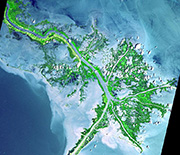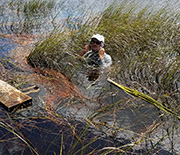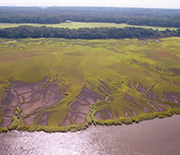News Release 18-052
NSF-supported researchers to present new results on hurricanes and other extreme events
Ecosystem resilience and human well-being topic of ecological sciences conference

In 2017, hurricanes devastated ecosystems from tropical forests to salt marshes.
July 17, 2018
This material is available primarily for archival purposes. Telephone numbers or other contact information may be out of date; please see current contact information at media contacts.
In the past year, extreme events -- including hurricanes, droughts and wildfires -- have plagued the U.S., affecting natural habitats and human communities.
The theme of the 2018 Ecological Society of America (ESA) meeting reflects the importance of these natural disasters. Conference participants will present the latest research findings on "extreme events, resilience and human well-being."
The meeting takes place Aug. 5 to 10 at the Ernest N. Morial Convention Center in New Orleans, a city still rebuilding in the aftermath of Hurricane Katrina more than a decade ago.
Worldwide, sea level is rising and river deltas are sinking, threatening the millions of people who live near these deltas.
The opening plenary talk by Robert Twilley of Louisiana State University, "Ecosystem design approaches in the highly engineered landscape of the Mississippi River Delta," focuses on research funded by the National Science Foundation's (NSF) Coastal Science, Engineering and Education for Sustainability (SEES) program. Twilley will also discuss globally threatened deltas in the presentation, "The resilience of coastal deltaic floodplains." The study is supported by NSF's Coastal SEES program.
More than 100 additional conference presentations and posters will feature research by scientists funded through NSF's Long Term Ecological Research (LTER), Critical Zone Observatories (CZO) and Biological Oceanography programs, among others. Twenty-eight NSF LTER and nine NSF CZO sites allow scientists to make sustained observations of extreme and unexpected events such as hurricanes. Long-term experiments at these sites provide researchers with opportunities to answer the question: "What conditions foster resilience?"
LTER and CZO sites in Puerto Rico, Florida and Georgia were hit hard by the 2017 hurricane season. Resilience in the face of repeated salt water flooding and forest damage has been challenging.
Scientists are now conducting research on the role of rainfall variability in ecosystems from tropical and coastal forests to estuaries and salt marshes. Nutrient and other experiments are also offering new insights into the interactions among myriad short-term and long-term environmental stresses.
For more information about NSF funding opportunities, join NSF program officers on Tuesday, Aug. 7, from 11:30 a.m. - 1:15 p.m. in room 352 of the Ernest N. Morial Convention Center. NSF representatives will talk about support for basic research and training in ecology and related disciplines: Navigating NSF: Opportunities for Funding Research and Training.
Below is an overview of NSF-funded presentations at the conference.
Monday, Aug. 6, 2018
Tuesday, August 7th, 2018
Wednesday, August 8th, 2018
Thursday, August 9th, 2018
Friday, August 10th, 2018
-NSF-
-
The Mississippi Delta before hurricanes Katrina and Rita destroyed a large part of it in 2005.
Credit and Larger Version -
NSF's Luquillo LTER and CZO sites after Hurricane Maria: the tropical forest there was uprooted.
Credit and Larger Version -
During Hurricane Irma, Florida's Shark River Slough saw its highest water levels ever recorded.
Credit and Larger Version -
Hurricane Irma severely affected the salt marshes of NSF's Georgia Coastal Ecosystems LTER site.
Credit and Larger Version -
At NSF's Virginia Coast Reserve LTER site, scientists study the impacts of higher storm surges.
Credit and Larger Version
Media Contacts
Cheryl Dybas, NSF, (703) 292-7734, email: cdybas@nsf.gov
The U.S. National Science Foundation propels the nation forward by advancing fundamental research in all fields of science and engineering. NSF supports research and people by providing facilities, instruments and funding to support their ingenuity and sustain the U.S. as a global leader in research and innovation. With a fiscal year 2023 budget of $9.5 billion, NSF funds reach all 50 states through grants to nearly 2,000 colleges, universities and institutions. Each year, NSF receives more than 40,000 competitive proposals and makes about 11,000 new awards. Those awards include support for cooperative research with industry, Arctic and Antarctic research and operations, and U.S. participation in international scientific efforts.
Connect with us online
NSF website: nsf.gov
NSF News: nsf.gov/news
For News Media: nsf.gov/news/newsroom
Statistics: nsf.gov/statistics/
Awards database: nsf.gov/awardsearch/
Follow us on social
Twitter: twitter.com/NSF
Facebook: facebook.com/US.NSF
Instagram: instagram.com/nsfgov







